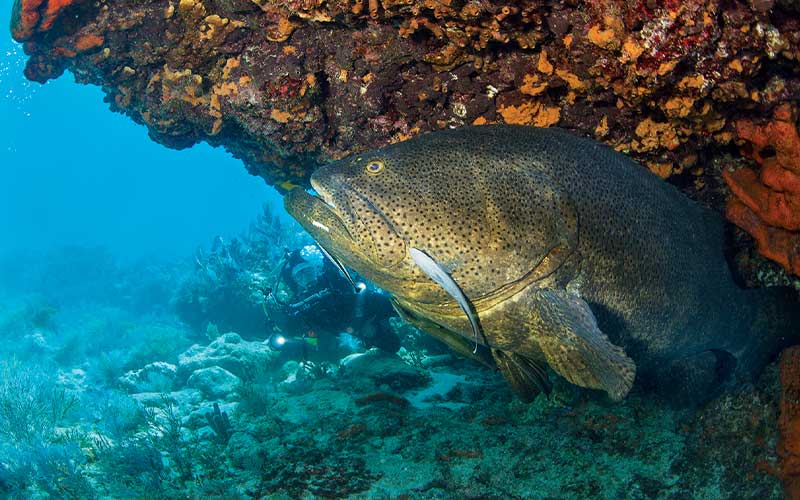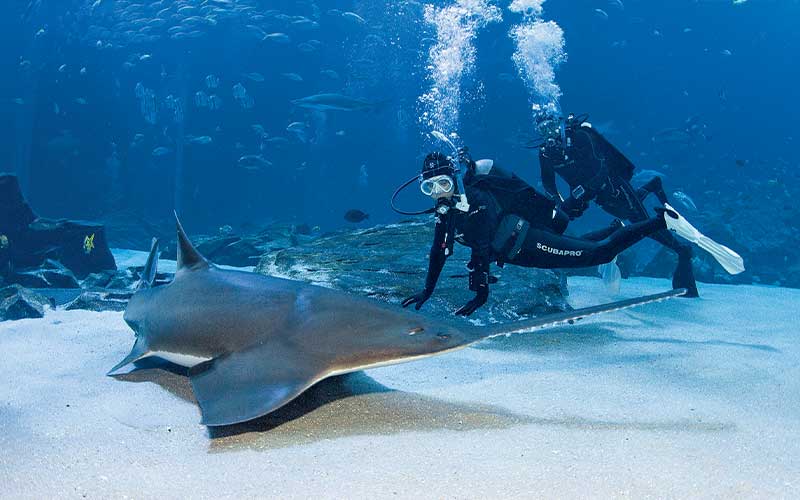For many divers and wildlife enthusiasts, there is no greater thrill than meeting large predatory fish in their own environments, where much closer observation and interaction is possible than with terrestrial predators. Such encounters can bolster a conservation ethos and strengthen people’s connection with the sea.
Three iconic predatory fish species of note are the great hammerhead (Sphyrna mokarran), smalltooth sawfish (Pristis pectinata) and Atlantic goliath grouper (Epinephelus itajara) — a shark, a ray and a teleost, respectively. Despite their differences, these fish actually have much in common: They are all broadly distributed throughout tropical coasts, often connecting estuaries and coral reefs; they reach maturity late and live long lives (29+ years for goliath grouper); they possess long gestation periods (up to 12 months for hammerheads); and they tend to produce few young (especially sharks and rays).

Unfortunately, their common life-history traits, combined with their strong site fidelity to coastal habitats, have rendered them highly vulnerable to exploitation. Researchers estimate that populations of great hammerheads in the western Indian Ocean decreased by 50 percent between 1978 and 2003, a figure dwarfed by their 73 percent decline in the Gulf of Mexico in the past two decades. Similarly, sawfish populations worldwide have been devastated, and goliath grouper sightings are rare today in some countries where the fish once abounded.
Over the past 17 years of working with traditional fishers in the Mesoamerican Barrier Reef (MBR) region that encompasses Mexico, Belize, Guatemala and Honduras, I have heard time and again about the marked decline in fish populations, most notably those of sharks and large groupers. Such stories catalyzed our efforts to assess the status of the threatened fish and the critical habitats where they feed, grow and reproduce. While there are several such studies of the populations and distribution of large terrestrial wildlife, examinations of large fish in tropical countries are rare and often limited to a single species.
Our recent examination of these three species in Belize indicated that while the barrier reef and offshore atolls continue to sustain several species of sharks and rays, hammerheads and goliath grouper are increasingly rare, and sawfish appear to have vanished completely. In our 10 years of survey work, we captured, tagged and released 13 adult goliath grouper, only four great hammerheads (all juveniles) and not a single sawfish. Although our work currently encompasses only Belize, conversations with local fishers in neighboring countries suggest that Belize possesses greater abundances of all indigenous fish species, which is cause for concern about the rest of the region.
The decline of these species in the MBR is largely due to Guatemala’s introduction of bottom-set nets in the mid-1970s and to the popularity of all three fish as food. Until the early 1970s, sawfish were abundant and widely distributed along the MBR, but the subsequent decade saw high sawfish mortality as the fish entangled their tooth-lined rostra in nets. Great hammerheads, likewise threatened by fishing nets, are also particularly vulnerable to the unrelenting demands of the Asian shark-fin market. In Latin America all three animals are hunted for their meat, which is prized as a Lenten-friendly alternative to red meat.

Stories of hope in other regions motivate our work in the MBR. A 1995 Florida state ban on gillnets, together with broad outreach and citizen participation in documenting sawfish sightings, has led to encouraging signs that Florida’s smalltooth sawfish populations are rebuilding. Likewise, bans on fishing goliath grouper in Brazil and southern Florida are helping populations to rebound. Jupiter, Fla., has even become a popular dive destination during the late summer and early fall when large numbers of goliath grouper come together in spawning aggregations. The increased income for the dive-tourism industry and related businesses could incentivize similar protective measures elsewhere, provided that fishers are integrated into the alternative, nonconsumptive economic activities.
Great hammerheads may also be catching a break after being listed in the Convention on International Trade in Endangered Species of Wild Fauna and Flora (CITES) in 2013. CITES requires signatory countries to implement measures ensuring the sustainability of hammerhead fisheries and trade or else incur sanctions and trade suspensions on all CITES-listed species. Still, unless countries make a major effort to reduce fishing pressure and, in particular, the use of nets that lead to high hammerhead mortality, decline will continue unabated.
With the disappearance of sawfish, the MBR continues to be a specific area of concern for hammerheads and goliath grouper. The area’s growing human population brings greater food and fuel prices, which will push local fishers to strategically concentrate their efforts on coastal areas and species with predictable behaviors. This bodes badly for remnant populations because fishers’ traditional knowledge reveals that female hammerheads move inshore to pup and feed on rays, and juvenile goliath grouper predictably inhabit estuarine coasts fringed with red mangroves. My organization’s field efforts are geared primarily toward working with local fishers, which gives us the opportunity to spread awareness and collaboratively identify means of reducing pressures on fisheries.
So what can you do to help these species survive? Support encounter tourism and bans on gillnets and fishing of threatened species. If you accidentally capture one of these fish, adhere to the following protocol: Take a photo with a known object to demonstrate scale; record the location, date, time, gear used and your assessment of the animal’s condition (excellent, good, poor or dead); release any living animal as quickly as possible; and send your photo and notes to your local fisheries department or to MarAlliance (info@maralliance.org). If the animal is dead, call your fisheries department or a marine biologist to help you take appropriate samples, which can provide important data for management plans. With your collective voices and support we can restore hammerhead and goliath grouper populations to their original ranges and bring them back from the brink.
© Alert Diver — Q3 Summer 2014